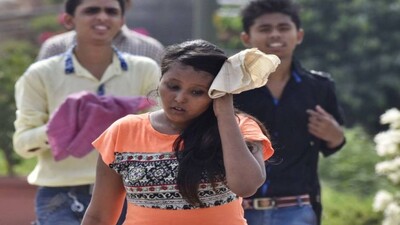Recommended Stories
As Japanese authorities scrambled to control overheating reactors and fresh radiation threats at the quake-hit Fukushima nuke reactor, the government warned of the risk of a second explosion.
The reactor faced serious troubles after its emergency cooling system failed, triggering a fresh radiation threat, a day after a blast rocked the site following country`s biggest quake, the magnitude of which has been revised from 8.9 to 9 by the Japanese Meteorological Agency.
The Fukushima power plant`s operator said pressure was rising inside reactor No.3 after it lost its cooling system.
The development came a day after a blast and leakage from the No. 1 reactor at Fukushima, 240 km north of the capital Tokyo. The explosion had blown off the roof and walls around the reactor.
"We cannot rule out the possibility of another explosion," Chief Cabinet Secretary Yukio Edano said. But he dismissed concerns about it having any significant impact on human health.
He said the trouble with the No. 3 reactor there has not led to a "meltdown," a critical situation where fuel rods have melted. A complete meltdown can lead to release of uranium and other radioactive materials in the environment and pose serious health risks.
Kyodo news agency said 1.80 lakh people were evacuated from a 20 kms radius from the nuke plant joining over 3.5 lakhs who have already moved out.
"We have no choice but to deal with the situation on the premise that it (the death toll) will undoubtedly be numbered in the ten thousands," Naoto Takeuchi, head of the Miyagi prefectural police was quoted as saying by Kyodo news.
The official tally shows 983 confirmed deaths in Miyagi and other areas. Over 600 bodies have been found in in Miyagi and Iwate prefectures on the Pacific coast. Miyagi includes the port of Minamisanriku, which was mostly swept away by gushing Tsunami waters.
Tokyo Electric Power Co, which runs the power station, notified Japan`s nuclear safety agency that the radiation level at the Fukushima No. 1 nuclear power plant had exceeded the legal limit.
Hourly radiation at the site was measured at 882 micro sievert, in excess of the allowable level of 500, Kyodo reported.
The nuclear safety agency also said the Tokyo Electric Company acknowledged that the No. 3 reactor of the Fukushima plant had lost its cooling functions, while at least 22 people are known to have been exposed to radiation.
The No.3 reactor had lost the ability to cool its core and was now in the process of releasing radioactive steam, Edano said.
It was the sixth reactor overall at the Fukushima No.
1 and No. 2 plants to undergo cooling failure since the massive earthquake and tsunami struck Japan on Friday.
Prime Minister Naoto Kan ordered rushing of additional Self-Defense Force personnel to quake-hit areas. Over one lakh SDF personnel, the largest such operation, will assist in the relief and rescue operations, Defence Minister Toshimi Kitazawa said.
"I would like to ask for maximum efforts in order to save the lives of as many people as possible," Kan told a Cabinet-level emergency disaster meet. "We will do everything to rescue stranded people."
In Miyagi, about 4,400 people had been sheltered in schools, hospitals and inns in the tsunami-swamped town of Onagawa and neighboring Ishinomaki city, local officials said.
Also, local governments have been unable to contact tens of thousands of people, and at least 20,820 buildings have been fully or partially damaged in quake-hit areas.
In Miyagi, about 200 more bodies were found in the city of Higashimatsushima, and about 10,000 people in Minamisanriku, over half the town`s population, remain unaccounted for, police said.
In neighboring Iwate Prefecture, 258 people have been confirmed dead and the death toll will rise above 500. The city of Rikuzen-takata has been devastated by a tsunami. Self Defence Forces say they have found 300 to 400 bodies there.
About 5,000 houses in the city had been submerged by the quake-triggered tsunami.
There were also tens of thousands of people that local governments had been unable to contact, police and local officials were quoted as saying.
About 4,400 people remained isolated as of Saturday night in the tsunami-swamped town of Onagawa and neighboring Ishinomaki city, in schools, hospitals, inns and the Onagawa nuclear plant where they had been evacuated to, Miyagi officials said.
In Iwate Prefecture, north of Miyagi, many bodies were found today under the rubble in Rikuzentakata, and the US military in Japan is poised to airlift about 640 isolated residents there by eight helicopters, the police and the Defence Agency said.
About 5,000 houses in the city had been submerged by quake-triggered tsunami, and the city office has confirmed that only 5,900 of its population of about 23,000 had taken shelter.
More than 215,000 people are said to be living in 1,350 temporary shelters in five prefectures in quake-hit areas. One report said four trains had disappeared following the quake and still had not been located.
International disaster relief teams are being sent to Japan, with the UN helping to coordinate the operation.
Japan`s worst previous earthquake was of 8.3 magnitude and killed 143,000 people in Kanto in 1923. A magnitude 7.2 quake in Kobe killed 6,400 people in 1995.
The Iwate government also said it has been unable to communicate with the mayor and officials in Otsuchi after the town office was swept away by a tsunami while the mayor and town officials were apparently inside the building. A nursing home accommodating 30 elderly people was also washed away in Ofunato city.
The Fukushima prefectural government said it was still unable to contact 1,167 residents, including 918 in the town of Namie, boosting the tally of those unaccounted for in its latest data.
Helicopters from the Maritime Self-Defense Force sent to check the extent of damage spotted bush fires at seven places in Miyako city early Sunday, the Defense Agency said.
Communication failures were also found to have extended further. Nippon Telegraph and Telephone East Corp.
said 475,400 fiber-optic services were disconnected as of 6 am, up 76,500 from 8 pm Saturday, in addition to 879,500 subscribed phone lines that remained out of service in areas centering on Iwate and Miyagi.
A total of 11,400 base stations of major cellphone operators NTT Docomo Inc., KDDI Corp. and Softbank Mobile Corp. stayed inoperative as of 7:30 a.m., disrupting phone calls and emails via mobile phones across wide areas, the Internal Affairs and Communications Ministry said.
Areas in Iwate, Miyagi and seven other prefectures remained unable to receive TV signals as of 10 a.m., it also said. Ground SDF troops, meanwhile, rescued about 5,800 people in the Miyagi town of Kesennuma and its vicinity, the Defense Ministry said.
An increasing number of search and rescue teams were arriving in Japan, with a total of 69 governments and five international institutions having offered assistance, the Foreign Ministry said.
In the evening the weather agency lifted the tsunami advisory that remained for the Pacific coast stretching from Hokkaido to Kyushu after downgrading its tsunami warning to an advisory in the morning for the Pacific side of the Tohoku region in northeastern Japan.
The government adopted a decree late Saturday designating the quake a serious disaster eligible for increased state subsidies for reconstruction.












